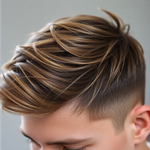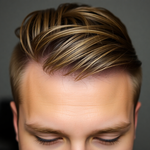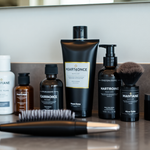
Cut Decision Fatigue: How Semi‑Permanent Hair Color Pairs with a Minimalist, Sustainable Men's Wardrobe
23 August 2025
Share
Cut Decision Fatigue: How Semi‑Permanent Hair Color Pairs with a Minimalist, Sustainable Men's Wardrobe
Struggling to look sharp every morning without overthinking outfits or grooming? Cut decision fatigue by pairing semi‑permanent hair color with a curated, sustainable wardrobe. This approach reduces daily choices, boosts confidence, and keeps things eco-friendly—perfect for men aged 18–45 who want low-effort style that still looks intentional. In this post you’ll get practical routines, a capsule checklist, color guidance, outfit formulas, and maintenance tips you can use today.
Why decision fatigue matters (and why style is a perfect target)
Decision fatigue is real: the fewer trivial choices you have to make, the more mental energy you preserve for work, relationships, and the gym. Clothing and grooming occupy a surprisingly large chunk of daily willpower for many men. A minimalist, sustainable men's wardrobe reduces outfit decisions, while semi‑permanent hair color takes one grooming variable off the table—hair tone and coverage stay consistent without long-term commitment.
How semi‑permanent hair color reduces decision fatigue
Semi‑permanent hair color evens out tone, hides greys, and can subtly warm or cool your natural color without the commitment and damage of permanent dyes. Because it fades gradually over 4–8 weeks, it leaves room for experimentation but keeps your look stable between applications. That means fewer panicked “Does my hair look odd?” moments before a meeting or date. Use the phrase "semi‑permanent hair color" as a simple grooming rule: consistent hair tone + a small, optimized wardrobe = fewer choices, more confidence.
Principles that link hair and wardrobe
- Reduce variables: keep hair tone consistent and limit clothing to a cohesive color palette.
- Prioritize fit and texture: when items fit well, you can wear fewer pieces and still look sharp.
- Buy intentionally: choose durable, repairable garments made from sustainable materials.
- Build reliable combos: create outfit formulas so you can dress quickly and intentionally.
Choosing the right semi‑permanent shade for your capsule wardrobe
Match hair undertone to your wardrobe palette to simplify outfit matching. Use these quick rules:
- Warm hair tones (warm chestnut, auburn) pair well with earthy colors: olive, camel, rust, and cream.
- Neutral-to-cool tones (ash brown, dark neutral) pair best with Navy, charcoal, black, and cool greys.
- Lightening slightly can add contrast for fair skin, while a touch darker adds depth for medium to dark complexions.
Keep changes subtle: one shade up or down is often all you need to create cohesion without drawing attention to the dye itself.
DIY vs. barber/salon: which route should you take?
-
DIY at home
- Pros: cheaper, convenient, control over timing.
- Cons: risk of uneven application—best for men with short hair or simple, natural shades.
-
Barber or salon
- Pros: professional blending, color correction, healthier application for more dramatic changes.
- Cons: higher cost and scheduling.
If you’re new to color, start at a salon for a consult and then switch to at-home maintenance with semi‑permanent products to extend visits.
Building your minimalist, sustainable men's wardrobe: a 20-piece guide
A capsule wardrobe doesn’t mean boring. It means strategic. Here’s a practical 20-piece list that works across seasons and matches most semi‑permanent hair tones.
- 2 plain tees (white, grey)
- 1 striped or patterned tee
- 1 casual button-up (navy or white)
- 1 Oxford or heavier button-up
- 1 midweight crew or half-zip sweater
- 1 lightweight knit (long-sleeve) for layering
- 1 versatile jacket (Menll.com’s outerwear collection is a strong option for sustainability and fit)
- 1 blazer or structured overshirt
- 1 pair dark denim
- 1 pair chinos (khaki or olive)
- 1 pair tailored trousers (for smarter needs)
- 1 casual sneaker (consider a sustainable option)
- 1 pair chukka or Chelsea boots
- 1 lightweight coat for rain or wind
- Underwear and socks in quality fabrics
- 1 belt, 1 minimalist watch, 1 scarf (seasonal)
- 1 pair shorts (for warm climates)
- 1 hoodie for laid-back days
- 1 activewear set
- 1 beanie or cap
Focus on neutral colors that work with your chosen hair tone and add 1–2 accent hues that complement it.
10 outfit formulas that save time
Memorize these 10 formulas and you’ll never stare at a closet again.
- White tee + dark jeans + clean sneaker
- Grey tee + olive chinos + boots
- Navy button-up + tailored trousers + Chelsea boots
- Crew sweater + white tee underneath + jeans
- Striped tee + chinos + sneaker
- Hoodie + jacket + jeans + boot
- Blazer + Oxford + tailored trousers (smart casual)
- Lightweight knit + shorts + sneaker (summer)
- Midweight sweater + jacket + dark jeans (date night)
- Active set + sneakers (gym to errands)
Low-effort grooming routine to pair with your hair and wardrobe
Keep it under 10 minutes. This routine preserves your semi‑permanent color and keeps your look consistent:
- Cleanse (use a sulfate-free shampoo to protect color) — quick rinse every 2–3 days.
- Condition once or twice a week, or use a color-safe conditioner after every wash if needed.
- Quick towel dry, then apply a light styling product—matte cream for texture, pomade for control.
- Daily skin prep: quick splash of cold water, light moisturizer with SPF for daytime.
- Monthly: reapply semi‑permanent color or touch-up at your barber.
Maintenance timeline: hair, clothes, and tools
- Weekly: rotate outfits, spot-clean garments, air out shoes.
- Bi-weekly: machine-wash only full loads, cold water, and low-heat drying when possible.
- Monthly: semi‑permanent color touch-up as needed; trim hair for shape every 6–10 weeks.
- Quarterly: evaluate wardrobe—repair, tailor, or donate items you haven’t worn.
Sustainable choices that actually make a difference
Buying less and buying better reduces carbon footprint and decision fatigue. Prioritize:
- Recycled materials (recycled polyester, Econyl)
- Natural, low-impact fibers (organic cotton, Tencel/Lyocell)
- Durable construction and timeless cuts
- Repairable items: find a cobbler, learn basic sewing
Remember, the most sustainable item is the one you wear for years.
Cost-per-wear thinking: spend smarter
A $200 jacket that you wear 200 times costs $1 per wear. A $30 fast-fashion jacket worn five times costs $6 per wear. Investing in a few higher-quality pieces—paired with affordable, effective semi‑permanent color maintenance—lowers long-term cost and reduces shopping decisions.
Real-life examples: who this works for
Case 1: Sam, 28, junior architect. He wanted to look intentional during presentations without daily effort. He chose a warm chestnut semi‑permanent color and built a navy/olive capsule. Now he has three outfit formulas that work for client meetings and weekend life.
Case 2: Daniel, 38, dad and startup founder. Short hair, going grey. He uses a subtle darkened semi‑permanent shade and relies on neutral basics plus a rainproof Menll.com jacket. He spends 10 minutes max prepping in the morning and feels put-together for school drop-offs and investor calls.
Frequently asked questions (FAQs)
- Does semi‑permanent dye damage hair? Minimal compared to permanent dyes because it doesn’t penetrate the hair shaft as deeply. Use color-safe, sulfate-free products for best results.
- How long does semi‑permanent color last? Typically 4–8 weeks depending on water, shampoo frequency, and product quality.
- Can I switch shades often? Yes—semi‑permanent dyes fade gradually, making it easier to experiment without long-term commitment.
- Is a minimalist wardrobe expensive? It can be cost-effective; the strategy is to invest in fewer, higher-quality pieces and reduce overall spending.
Resources and references
For context on hair dye safety and chemical concerns, see this overview from WebMD: WebMD: Hair Dye Safety. For sustainable fashion resources and data, consult reputable industry reports when researching brands.
SEO and publishing notes
Suggested URL: /blog/cut-decision-fatigue-semi-permanent-hair-color-minimalist-sustainable-mens-wardrobe
Meta title (50–60 chars): Cut Decision Fatigue: Semi‑Permanent Hair Color + Minimalist Wardrobe
Meta description (150–160 chars): Cut decision fatigue with semi-permanent hair color and a minimalist, sustainable men's wardrobe. Actionable tips, capsule checklist, and routines.
Suggested alt text examples for images:
- Man with subtle chestnut semi-permanent hair color wearing a navy jacket
- Menll.com EcoSneak Casual Shoes paired with dark denim—urban setting
- Capsule wardrobe laid out flat: neutral tees, chinos, boots
Final takeaway and call to action
Pairing semi‑permanent hair color with a minimalist, sustainable men's wardrobe is a practical way to cut decision fatigue, project confidence, and lower environmental impact. Start small: pick a subtle shade to stabilize your hair tone, create three reliable outfit formulas, and invest in a few sustainable staples. Which pairing will you try first—the warm chestnut with olive chinos or the cool ash with navy? Tell us in the comments and browse Menll.com for curated, sustainable pieces to complete your capsule.
Vorheriger Beitrag

Color‑Code Your Closet: Semi‑Permanent Hair Color Tips for a Sustainable Men's Capsule Wardrobe
Aktualisiert am 23 August 2025
Nächster Beitrag

Minimal Risk, Maximum Cohesion: Use Semi-Permanent Hair Color to Unite Your Sustainable Men's Capsule Wardrobe
Aktualisiert am 21 August 2025





